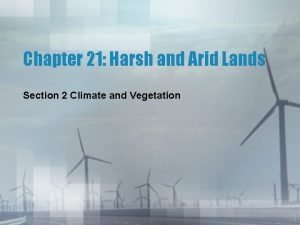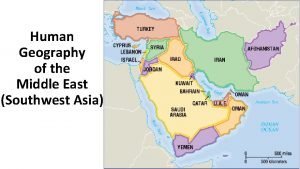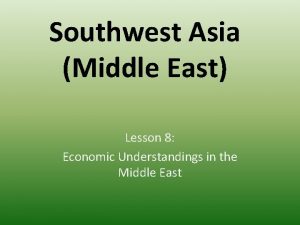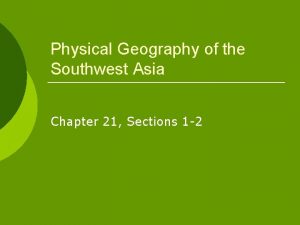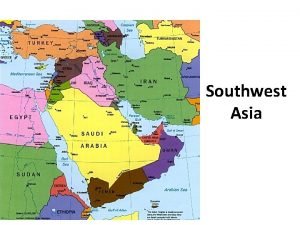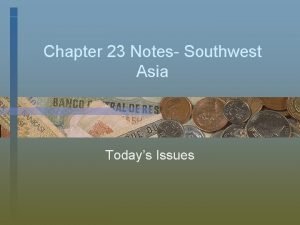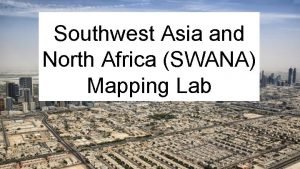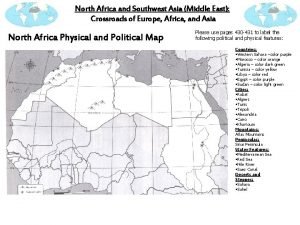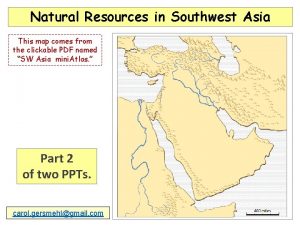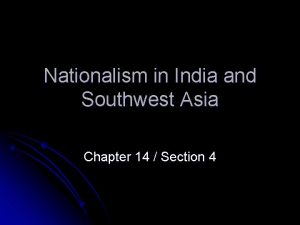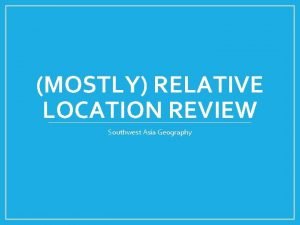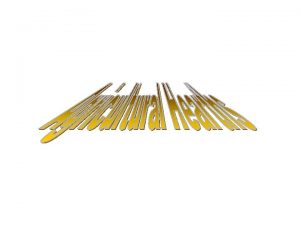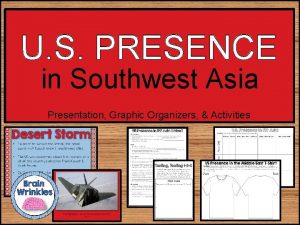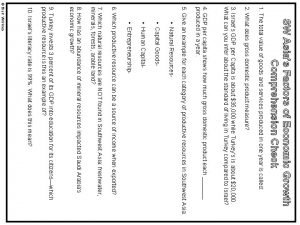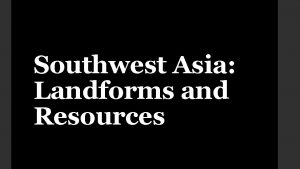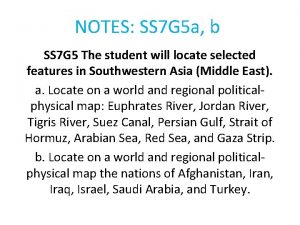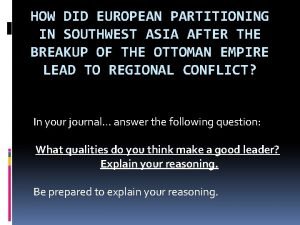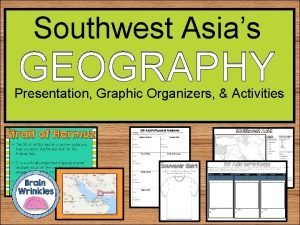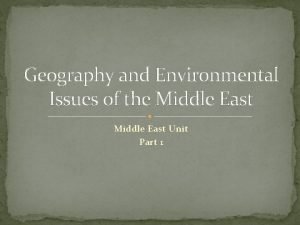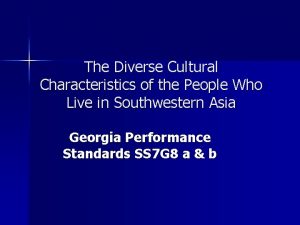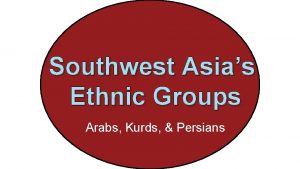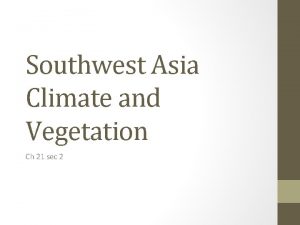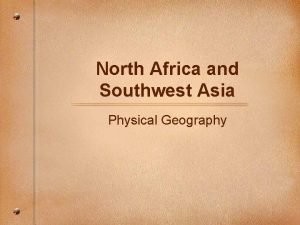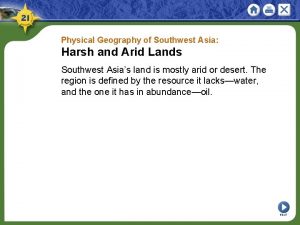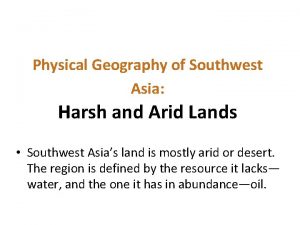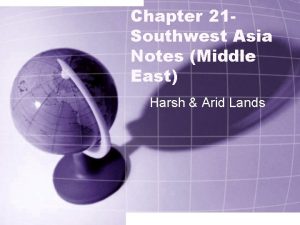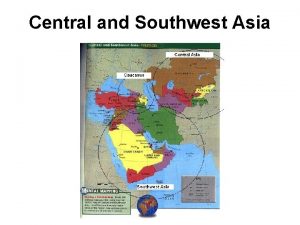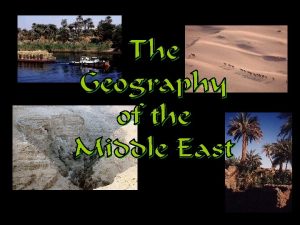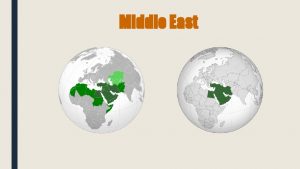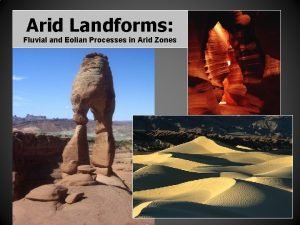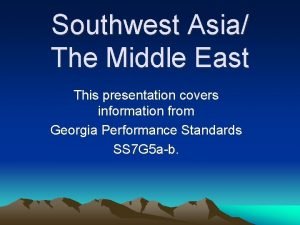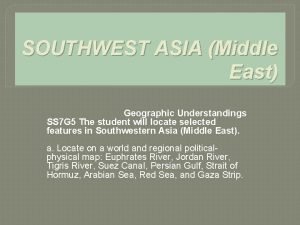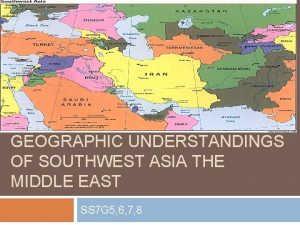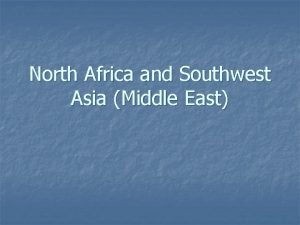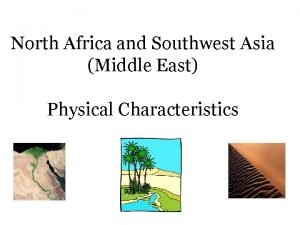Chapter 21 Southwest Asia Middle East Harsh Arid





































- Slides: 37

Chapter 21 - Southwest Asia (Middle East) Harsh & Arid Lands

Section 1 Landforms & Resources

Sulemaniye Mosque Turkey

Syria Damascus Umayyad Mosque

Parliament Square in Beirut Lebanon

Tel Aviv Dead Sea Salt Beds Negev Desert Israel Dome of the Rock

Jordan Abdullah Mosque Amman One of the new 7 wonders of the world Petra King Abdullah II

Saddam Hussein Iraq Bombing of Baghdad Tigris River

King Fahd Empty Quarter Saudi Arabia

Iran Tehran Shahid Motahari Mosque

Sanaa Yemen

Mosque Oman Sultan’s Palace

Abu Dhabi United Arab Emirates

Museum Doha Qatar Desert

Kuwait Water Towers Kuwait City Oil wells

Section 1 - Landforms & Resources Peninsulas & Waterways Peninsula- area of land that is almost completely surrounded by water, except for a small portion connecting it to the mainland Strait- narrow body of water connecting 2 larger bodies of water

Section 1 - Landforms & Resources Suez Canal- artificial waterway between the Mediterranean Sea & the Red Sea

Section 1 - Landforms & Resources Arabian Peninsula- very dry, sandy, & windy, covered by plains. Wadis- riverbeds that remain dry except for the rainy season.

Section 1 - Landforms & Resources Water is the most important resource in this region Tigris & Euphrates river valleys supported several ancient societies

Section 1 - Landforms & Resources Jordan River- provides a natural boundary for Israel & Jordan Flows into the Dead Sea

Section 1 - Landforms & Resources Dead Sea- landlocked salt lake So salty that only bacteria lives in it Lowest place on the exposed surface of the earth. 1349 feet below sea level

Section 1 - Landforms & Resources Oil Largest reserves in the world (1/2 of all known reserves) Most prominent resource Water is still most valuable resource in SW Asia

Section 2 - Climate & Vegetation Rub Al-Khali (the empty quarter) Size of Texas One of largest sandy deserts in world Surface temps, can reach 150° 10 years may pass w/out rain



Section 2 - Climate & Vegetation Salt Flat- flat land made of chemical salts that remain after winds evaporate the moisture in the soil Common in Iran Usually uninhabited

Pamukkale is one of the extraordinary natural wonders of Turkey. The great attraction is the white immensity of the cliffs with sculptured basins full of water and congealed waterfalls; they seem done of snow, cloud, or cotton.

The scientific explanation is the hot thermal places that lie under the mount provoke the calcium carbonate spill, that makes the forms as solid as marble.

Tourists come to bathe; the Turks call this place PAMUKKALE, which means "Castle of Cotton".


Section 3 - Human-Environment Interaction Fresh water supplies are available only in small amounts Dams are very controversial in this region as they affect multiple countries at once.

Section 3 - Human-Environment Interaction Water Conservation is a major priority in SW Asia Drip Irrigation- practice of using small pipes that slowly drip water just above ground

Section 3 - Human-Environment Interaction Desalinization- removal of salt from ocean water Very expensive Can’t meet all needs

Section 3 - Human-Environment Interaction Fossil Water- water pumped from underground aquifers Little chance of being refilled in this area because of little rainfall

Section 3 - Human-Environment Interaction Petroleum- remains of plants & animals, formed from pressure & heat over millions of years. Oil is not in big pools under the ground, it is trapped in the pores of rocks. Taken out of ground by pressure

Section 3 - Human-Environment Interaction Crude Oil- petroleum that has not been processed Refinery- converts crude oil into useful products like gasoline & kerosene

Section 3 - Human. Environment Interaction Oil Spills are a risk when transporting oil in narrow straits or around reefs Largest in U. S. History is the Exxon Valdez spill in 1989
 Chapter 21 harsh and arid lands
Chapter 21 harsh and arid lands Human geography of middle east
Human geography of middle east Lesson 8 middle east and south asia
Lesson 8 middle east and south asia Chapter 22 human geography of southwest asia
Chapter 22 human geography of southwest asia Map of southwest asia
Map of southwest asia Peninsulas and waterways in southwest asia
Peninsulas and waterways in southwest asia Chapter 23 today's issues southwest asia
Chapter 23 today's issues southwest asia North american
North american Brain wrinkles southwest asia
Brain wrinkles southwest asia Southwest asia landforms
Southwest asia landforms Swana countries map
Swana countries map Political map of north africa and southwest asia
Political map of north africa and southwest asia Political map of north africa and southwest asia
Political map of north africa and southwest asia Southwest asia natural resources
Southwest asia natural resources Nationalism in india and southwest asia
Nationalism in india and southwest asia Relative location of israel
Relative location of israel Southwest asia hearth
Southwest asia hearth Brain wrinkles southwest asia answer key
Brain wrinkles southwest asia answer key Voluntary trade comprehension check
Voluntary trade comprehension check Se asian economies comprehension check answer key
Se asian economies comprehension check answer key Judaism vs islam chart
Judaism vs islam chart Kurdish coat of arms
Kurdish coat of arms Southwest asia landforms
Southwest asia landforms Tigris river map
Tigris river map Nationalism in southwest asia
Nationalism in southwest asia Europe partitioning in southwest asia answer key
Europe partitioning in southwest asia answer key Kums definition geography
Kums definition geography Brain wrinkles southwest asia
Brain wrinkles southwest asia Nationalism in india and southwest asia
Nationalism in india and southwest asia Nationalism in india and southwest asia
Nationalism in india and southwest asia Southwest asia map kuwait
Southwest asia map kuwait North africa southwest asia physical map
North africa southwest asia physical map Which ethnic group is most numerous in southwest asia
Which ethnic group is most numerous in southwest asia Kaaba location
Kaaba location Water pollution and unequal distribution illustration
Water pollution and unequal distribution illustration Why is water pollution of great concern in southwest asia
Why is water pollution of great concern in southwest asia Southwest asia vegetation
Southwest asia vegetation North africa and southwest asia mountains
North africa and southwest asia mountains
